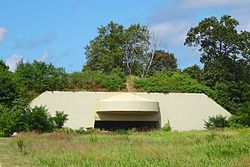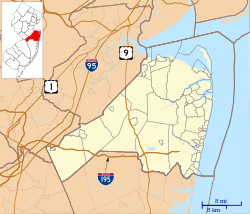Highlands Air Force Station
| Highlands Air Force Station General Surveillance Radar Station | |
|---|---|
| Code | L-12: 1948 Lashup Radar Network P-9: 1949 ADC permanent network Z-9: 1963 July 31 NORAD network |
| Site information | |
| Controlled by | |
| Site history | |
| In use | 1948-1966 |
| Garrison information | |
| Past commanders | Major Weston F. Griffith (1955-1961) |
| Garrison | |
Highlands Air Force Station was a
military installation in Middletown Township near the borough of Highlands, New Jersey.[1] The station provided ground-controlled interception radar coverage as part of the Lashup Radar Network and the Semi-Automatic Ground Environment network, as well as providing radar coverage for the Highlands Army Air Defense Site. The site's 240 acres (97 ha)[1] is now the Rocky Point section in Hartshorne Woods Park of the Monmouth County Parks System
.
The Navesink Military Reservation (also called the Highlands Military Reservation) was added as a historic district to the National Register of Historic Places on 13 October 2015.[2]

History
Early installations
The Navesink Highlands had a sea navigation beacon in 1746,flag signaling experiments that communicated with Fort Tompkins on Staten Island in 1859.[6]: 30 In 1899 Guglielmo Marconi built a radio station on the hill next to the north tower of the Navesink Twin Lights to report on the America's Cup races off of Sandy Hook.[5]
Seacoast defense and 1930s radar testing
Navesink Military Reservation Historic District | |
 Battery Lewis - Casemate front | |
| Location | Grand Tour Road and Portland Road, Middletown Township, New Jersey |
|---|---|
| Coordinates | 40°23′26″N 73°59′20″W / 40.39056°N 73.98889°W |
| NRHP reference No. | 15000011[7] |
| NJRHP No. | 5389[8] |
| Significant dates | |
| Added to NRHP | 13 October 2015 |
| Designated NJRHP | 28 August 2015 |
In 1917 during World War I, four
6-inch M1903 guns on the hill to the south of the Twin Lights Lighthouse.[10][11][17] The batteries were garrisoned by the United States Army Coast Artillery Corps as part of the Harbor Defenses of New York. Battery Lewis was one of the primary batteries guarding Greater New York in World War II, along with another 16-inch battery at Fort Tilden in Queens and two 12-inch long-range batteries at Fort Hancock on Sandy Hook.[9] These rendered all previous heavy guns in the area obsolete, and these were gradually scrapped during the war.[10] After World War II it was determined that gun defenses were obsolete, and the guns at Navesink were scrapped in 1948.[17]
Twin Lights station
The Twin Lights
General Electric AN/GPS-3 Radar[20] that remained until 1960.) Nine units of officers housing were built in 1955 near Battery 219. In March 1957 the Highlands Air Force Station began operating the first Bendix AN/FPS-14 Radar in the nation at the radar Gap Filler site P-9A in Gibbsboro, New Jersey until 1960. In 1958, four General Electric AN/FPS-6 Radar were added to the site along with a General Electric AN/FPS-7 Radar
.
SAGE site
In 1958, Highlands Air Force Station began providing data to
AN/FPS-26A and AN/FPS-90 sets. On 31 July 1963 the site was redesignated as NORAD ID Z-9. The United States Secretary of Defense announced on 20 November 1964, that the Air Force operations would be closed.[23]
The
Nike missiles. HAADS assumed control of the USAF station after the DoD announced its closure for July 1966.[1][24] The 646th Radar Squadron (SAGE) was inactivated on 1 July 1966. The Army's use of the site ended in 1974 under Project Concise when the Nike missile program ended.[25] Most of the buildings were demolished in the mid-1980s and mid 1990s,[26] and a few building foundations remain in a small clearing within the site's overgrowth of vegetation. However, the concrete remains of Battery Lewis, Battery 219, and the Plotting and Switchboard Bunker still stand.[27]
Present
The area is now
16"/50 caliber Mark 7 gun, formerly a spare for the Iowa-class battleships
, was placed on display in one of the gun positions of Battery Lewis.
| External image | |
|---|---|
See also
References
- ^ The Daily Register. Red Bank, New Jersey. 20 November 1964. p. One. Archived from the original(PDF) on 25 April 2012. Retrieved 10 October 2011.
Gov. Richard J. Hughes said yesterday he had been informed that a radar unit at the Air Force facility would be inactivated by July, 1966, affecting approximately 19 civilian employees and 186 military personnel.... Lt. Col. Ralph W. Frank, Jr., commander of the Air Force Station, indicated that the U.S. Army radar unit stationed at the base will be left intact.... The Army radar unit consists of approximately 300 men, of which about 200 are tied in with Fort Hancock operations or Sandy Hook as part of the U.S. Army Defense Command, according to the Air Force base commander.... According to the base commander, the entire Highlands Air Force Station, including the Missile Master, occupies about 241 acres, of which 103 undeveloped acres have been approved by the assistant secretary of defense as surplus property.... If land were to become available, it's probable that Middletown Township would have first claim on it, Mayor Guiney said. The installation, though named for this borough, is actually located in the township, the mayor reported, but it is serviced by the Highlands Post Office. "Geographically, Middletown could gain from this – possibly new ratables," said Mayor Guiney.
- ^ "Navesink Military Reservation Historic District". National Park Service. Archived from the original on 21 September 2016.
- Red Bank Register. Red Bank, New Jersey. 7 August 1958. Archived(PDF) from the original on 25 April 2012. Retrieved 9 October 2011.
- ^ "646th Radar Squadron (SAGE)". New York Air Defense Sector Yearbook. 1960. Retrieved 9 October 2011.
- ^ ISBN 0-7385-2362-3.
- ^ Rauch, Steven J. "Edward P. Alexander versus Albert J. Myer: Success and failure at the Battle of Bull Run" (PDF). United States Army Communicator: Voice of the Signal Regiment. 36 (3). Archived from the original (PDF) on 20 September 2011. Retrieved 9 October 2011.
Both Myer and Alexander…carried out a final series of trials with Myer stationed on the New Jersey Highlands and Alexander 15 miles away at Fort Tompkins on Staten Island. … Alexander…could read signals made with a four-foot flag on a 12-foot pole "with [only] a small and weak glass."
- ^ "National Register Information System". National Register of Historic Places. National Park Service. 9 July 2010.
- ^ "New Jersey and National Registers of Historic Places - Monmouth County" (PDF). New Jersey Department of Environmental Protection - Historic Preservation Office. 22 August 2016. p. 11. Archived from the original (PDF) on 16 October 2014.
- ^ )
- ^ a b c Berhow, p. 210
- ^ a b "New Jersey Forts". northamericanforts.com. Archived from the original on 17 November 2010.
- ^ "Richard Hartshorne at HighlandsNJ.com". Archived from the original on 20 December 2016.
- ^ "Richard Hartshorne at RichardRiis.com". Archived from the original on 20 December 2016.
- ^ "Chapter 4 - Cultural Resources Report - 1996". 1996. Archived from the original on 2 April 2015.
- ^ Davis, Harry M. (1st Lt) (1972) [1943, declassified 1972]. "Chapter IV". The Signal Corps Development of U.S. Army Radar Equipment. Signal Corps. Archived from the original on 26 April 2012. Retrieved 8 October 2011.
The Ordnance Department, which had voluntarily relinquished the "[radar]" project to the Signal Corps in 1930, now argued…that the data from a short-wave radio detector might eventually be applied directly to the gun director, eliminating the searchlight and replacing the sound locator. …the opening of the new Squier Laboratory building at Fort Monmouth, the personnel on 30 June 1936 consisted of only eight officers, seventeen enlisted men and ninety-two civilians.
{{cite book}}: CS1 maint: numeric names: authors list (link) - ^ a b Vieweger, Arthur L; White, Albert S. (1956). Development of Radar SCR-270 (Report). p. 23. Archived from the original on 6 September 2013. Retrieved 8 October 2011.
Such radars were therefore imported from England for analysis and comparison in a field set-up at the Signal Corps Radar Laboratory, in Belmar, N. J. … final version of SCR-271 with… Transmitter Peak Power - 500 KW (using the same WL-350 tubes); Pulse Width - 20 microseconds - Antenna - 64 dipoles 8 × 8 configuration; Antenna Beam Width Approx. 10° … at Oakhurst, N. J. … "Diana" using the major components of SCR-271…succeeded in…receiving echoes from the moon in January 1946.
- ^ a b "Highlands Military Reservation - FortWiki Historic U.S. and Canadian Forts". fortwiki.com. Archived from the original on 20 December 2016.
- ^ McKinney, John B. (August 2006). "Radar: A Case History of an Invention" (PDF). IEEE A&E Systems Magazine. 21 (8 Part II).[permanent dead link]
- (PDF) from the original on 27 September 2012. Retrieved 13 November 2011.
Secretary Woodring was discovered to have brushed the stop button on the rectifier unknowingly.
- ^ The AN/GPS-3 is composed of a surveillance radar set,[e.g., radar set of the AN/FPS-8] Tower AB-397/FPS-8, and Radar Recognition Set AN/UPX-6. Source: MIL-HDBK-162A Radar Set, Integrated Publishing, 15 April 1964
- The Daily Register. 20 November 1964. p. One. Archived from the original(PDF) on 25 April 2012. Retrieved 4 February 2013.
Lt. Col. Ralph W. Frank, Jr., left, commander of Highlands Air Force Station, and Capt. John W. Nolan, commanding officer of U. S. Army Signal Support Detachment stationed at bate, review roster of men to be detached from installation under directive issued yesterday by U.S, Defense Secretary Robert S. McNamara. Air Force personnel will be inactivated by July, 1966, leaving Army radar unit at base intact, according to Lt, Col. Frank.
- ^ "Awarded Army Medal" (PDF). Red Bank Register. 5 June 1964. p. 12. Archived (PDF) from the original on 25 April 2012.
- The Daily Register. Washington, DC. p. One. Archived from the original(PDF) on 25 April 2012. Retrieved 10 October 2011.
Over the past four years 574 U.S. military bases around the world... have been closed or their activities sharply cutback. Thursday, he tacked another 95 to the list.... McNamara struck 16 more Air Defense Command radar stations from the category of necessary installations.
- The Daily Register. Red Bank, New Jersey. 20 November 1964. p. One. Archived from the original(PDF) on 25 April 2012. Retrieved 10 October 2011.
The latest stroke of McNamara's economy scalpel cut at two naval shipyards employing a total of 17,000 workers, six bomber bases, Army and Air Force training sites, arsenals, radar posts and other installations in 33 states and the District of Columbia.... The actions will be completed for the most part by mid-1966...
- ^ "Chapter IX Logistics". Department of the Army Historical Summary: Fiscal Year 1974. Center of Military History. 1978. Archived from the original on 10 November 2013. Retrieved 8 October 2011.
- ^ Payette, Pete (21 February 2011). "New Jersey Forts". American Forts Network. Archived from the original on 17 November 2010.
- ^ "Military - The Lostinjersey Blog - Page 3". lostinjersey.wordpress.com. Archived from the original on 21 February 2014.
Bibliography
- Berhow, Mark A., ed. (2015). American Seacoast Defenses, A Reference Guide (Third ed.). McLean, Virginia: CDSG Press. ISBN 978-0-9748167-3-9.
- Lewis, Emanuel Raymond (1979). Seacoast Fortifications of the United States. Annapolis: Leeward Publications. ISBN 978-0-929521-11-4.
External links
- List of all US coastal forts and batteries at the Coast Defense Study Group, Inc. website
- FortWiki, lists most CONUS and Canadian forts




